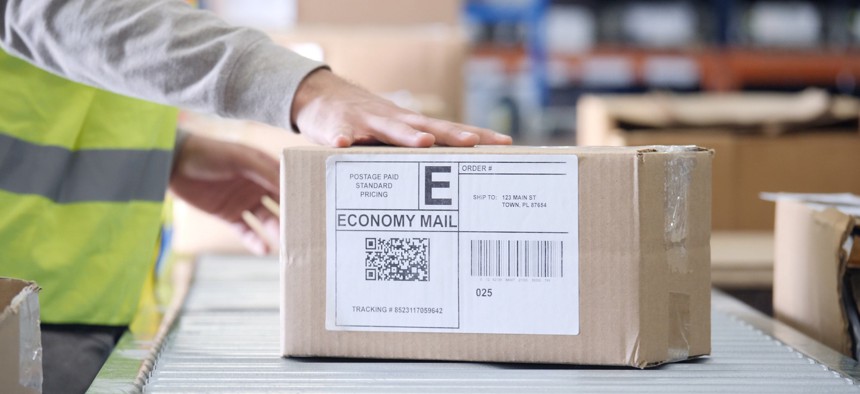
An inspector general's report found that new USPS sorting facilities were operating well, despite unfinished work impacting employees like electrical upgrades and temporary bathrooms. SDI Productions / Getty Images
New, consolidated USPS facilities are operating smoothly, but not yet delivering on improved working conditions
The Postal Service opened its new facilities before bathrooms and break rooms were built.
The U.S. Postal Service has found initial success as it consolidates mail and package sorting operations into centralized facilities, though it is failing to deliver on workplace improvements that management had promised as a means to boost morale.
USPS has opened its new facilities without yet including permanent bathrooms, break rooms or locker rooms, according to an inspector general’s audit, forcing employees to use mobile restrooms and other temporary spaces. From an operational perspective, however, the new centers are largely operating smoothly and functioning as designed. New machines are sorting packages more quickly, allowing USPS to meet its targets, and mail has been efficiently sorted for carriers.
USPS is in the opening stages of reforming its entire network, including standing up "sorting and delivery centers" that consolidate mail sorting into fewer facilities. The changes, which USPS has slowly rolled out in recent months and will accelerate later this year and in early 2024, will mean letter carriers no longer go to their local facility to pick up mail for their route, instead traveling farther distances after starting at a consolidated location. The impacted post offices will still conduct their retail operations, but a lot of the back-end functions will be stripped away and relocated.

The Postal Service’s inspector general reviewed the initial consolidation efforts at seven facilities, which serve as an opening salvo in what will ultimately be the centerpiece to Postmaster General Louis DeJoy’s 10-year plan to remake the mailing agency. It praised USPS for its initial successes, as well as for documenting lessons learned and ways to improve the process in the future. The centers have provided sufficient loading space and employees have been provided necessary equipment. USPS said for future sorting center openings it would ensure it improves manager training, boost internet connectivity, solicit additional information from employees on layout and improve communications with workers.
The auditors faulted postal management, however, for failing to complete improvements before opening the facilities. In addition to the unfinished employee spaces, electrical upgrades were still in progress, mail security cages were not yet installed and safety hazards—such as construction equipment on the floor and blocking exits—were pervasive. Even after the sorting centers were open for four months, the IG found, employees in some cases were still using temporary trailer-based bathrooms.
DeJoy has boasted the new facilities would add “employee amenities” at plants and improve lighting to “reduce stress and improve morale.” He likened the existing facilities to "dungeons" and said they are causing USPS to lose employees. USPS was undermining that promise by failing to provide basic necessities, the IG noted, adding that USPS faces an obligation under the 1970 Occupational Safety and Health Act to provide a “safe and healthy workplace free of recognized hazards.”
“While completing all construction projects could delay the opening, completing restrooms and other items that directly impact employee comfort and safety would allow employees to report to a welcoming workspace, free of hazards, to help ease their transition into the S&DC environment,” the IG said. “Additionally, requiring employees to work under these conditions could potentially place employees at physical risk, increase grievances or result in poor employee engagement.”
Going forward, the watchdog said postal management should ensure construction of bathrooms, break rooms and locker rooms are completed prior to opening new sorting centers. USPS said it would include a requirement in its construction documents, but will continue to provide “temporary accommodations” when regular facilities cannot be completed in a timely fashion. Postal management told the IG that finishing construction on bathrooms and other spaces would have delayed the sorting and delivery center initiative and those areas were “not related to S&DC operations.”
The watchdog said the Postal Service had generally been successful in communicating its plans internally, but failed to do so with external stakeholders. Mailers and shippers were not made aware of timelines or locations of changes, nor were they afforded the opportunity to provide feedback. Those companies reported hearing about the reforms secondhand. Improved communications, the IG said, would lead to more confidence in the changes.
The consolidation plan has also led to USPS not meeting its scheduled time for mail delivery at Post Office Boxes. That process has become much more complicated, as mail previously was sorted at the post offices themselves and was therefore able to be quickly placed in the on-site boxes. USPS has fielded complaints about the delays, which the IG said could lead to lost revenue. Postal management agreed to review its processes and adjust its scheduled delivery times as necessary.
While many in the postal community have praised DeJoy and USPS management for taking necessary steps to make improvements to the agency’s physical infrastructure, the remaking of its network has been met with some controversy. USPS has, at times, faced bipartisan criticism, employee protests and stakeholder concerns. The Postal Regulatory Commission in June rejected USPS management’s bid to block the watchdog from leveling additional scrutiny aimed at the network changes, saying the overhaul could have dramatic impacts on “every aspect of the postal environment” and therefore required review.







